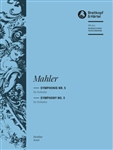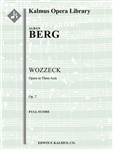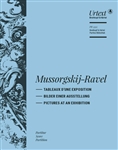
|

|

|

|
 |
 MAHLER, Gustav (1860-1911) - Symphony No. 5 in C-sharp minor (critical edition) (Pfefferkorn/Riedel). BREITKOPF & HAERTEL
MAHLER, Gustav (1860-1911) - Symphony No. 5 in C-sharp minor (critical edition) (Pfefferkorn/Riedel). BREITKOPF & HAERTEL
|
|
|

PB05635 / orch: 4d1, 3d1, 3d D/Eb Bcl, 3d1 - 6, 4, 3, 1, timp, perc, 2hp, str / Dur 65
**** IN PREPARATION. BACKORDERS BEING ACCEPTED. ORDERS WILL BE FILLED AS EARLY AS JANUARY, 2025, BUT COULD BE LATER. ****
(IMPORT POSTAGE MAY APPLY.)
Textcritical Edition edited by Nick Pfefferkorn and Christian Rudolf Riedel [orch] Duration: 74'
4(4picc).3(cor ang).3(D/Eb.B-clar).3(dble bsn) – 6.4.3.1 – 2hp.timp.perc(4) – str
- Spacious format for optimal legibility
- Practical page turns, useful cue notes
- Clarinets “in D” and “in C” also “in Eb” and “in Bb” in the parts
- Percussion score instead of separate parts

|

|
 |

|

|

|

|
 |
 JANACEK, Leos (1854-1928) - Sinfonietta (ILJ 22) (Fuessl). EDWIN F. KALMUS
JANACEK, Leos (1854-1928) - Sinfonietta (ILJ 22) (Fuessl). EDWIN F. KALMUS
|
|
|

A9338 / orch

|

|
 |

|

|

|

|
 |
|
MAHLER, Gustav (1860-1911) - Symphony No. 9 in D (Riedel) (Critical Edition). BREITKOPF & HAERTEL
|
|
|

PB05639 / orch / Dur 75
Textcritical Edition edited by Christian Rudolf Riedel [orch] Duration: 75'
picc.4.4(cor ang).5(Eb-clar.Bb-clar).4(dble bsn) - 4.3.3.1 - 2hp.timp.perc(4) - str
-string parts with and without Mahler's bowing marks
-(marked part is included with the set as a set-up aid)
-scoring with two harps as arranged by Bruno Walter
-spacious layout for optimal legibility
-suitable page turns and cue notes
-aids for orientation and instrument changes
*** PLEASE NOTE: IMPORT POSTAGE APPLIES (FEDEX ECONOMY FROM GERMANY)

|

|
 |

|

|

|

|
 |
|
SCHUMANN, Robert Alexander (1810-1856) - Concerto for Cello in A minor, Op.129 (Urtext) (Kate Bennett Wadsworth). BAERENREITER VERLAG
|
|
|

BA08839 / vc, orch: 2, 2, 2, 2 - 2, 2, 0, 0, timp, str, solo vc / Dur 23
- Scholarly-critical edition of the concerto's version authorized by Schumann
- With detailed textual and audiovisual documentation on performance practice
Volume / Series
BAERENREITER URTEXT
Editor
Wadsworth, Kate Bennett
Instrumentation of the work
Orchestra
Language(s) of text
German, English
Product format
Score, Urtext edition
Pages / Format
XXXIII, 70 S. - 31,0 x 24,3 cm

|

|
 |

|

|

|

|
 |
 MUSSORGSKY, Modest Petrovich (1839-1881) - Pictures at an Exhibition (Ravel). LUCK'S MUSIC LIBRARY
MUSSORGSKY, Modest Petrovich (1839-1881) - Pictures at an Exhibition (Ravel). LUCK'S MUSIC LIBRARY
|
|
|

LUC12733 / orch: 3d1, 3d1, 2+1, 2+1, sax - 4, 3, 3, 1, timp, perc, 2hp, cel, str / Dur 29
Pictures at an Exhibition (Ravel) (Masterworks Series).
Errata corrected. Transposed parts: Cl 1+2, Bass Cl in Bb, Tpt 1-3, Trbn 1+2. Orchestrated by Ravel. Solo tuba in Bydlo.

|

|
 |

|

|

|

|
 |
 BERG, Alban (1885-1935) - Wozzeck (complete). EDWIN F. KALMUS
BERG, Alban (1885-1935) - Wozzeck (complete). EDWIN F. KALMUS
|
|
|

A9313 / opera
4.4(4th dEH).4+BCl.3+CBsn: 4.4.4.1: Timp(2).Perc(3-4): Clst.Hp: Str (4-4-3-3-3 in set): Banda: OnStg Pno: Vocal Soli (12 roles: STrebleATTTTBarBarBarBB): Mixed Chor.
Austrian composer Alban Berg (1885-1935) composed the three-act opera Wozzeck between 1914 and 1922 after seeing a production of German playwright Georg Büchner's incomplete drama Woyzeck. Beginning the work in 1914, including the adaptation of Büchner's text into a libretto, Berg's obsession with completing the opera was interrupted by his serving in the Austro-Hungarian Army from 1915 to 1918 and during World War I, an experience which significantly altered his approach to Wozzeck. The plot, which depicts the lives of the inhabitants and soldiers of a rural German-speaking town, follows the title character as he is abused by the soldiers and deals with the infidelity of his wife, who he eventually murders before drowning himself. The opera ends with Wozzeck's son obliviously continuing to play with the other children as word of his murdered mother begins to spread. The opera finally premiered by the Berlin State Opera, Erich Kleiber conducting, on December 14, 1925, eleven years after Berg began work. It is considered the first avant-garde opera, and it famously employs atonality and Sprechgesang, although it does make use of leitmotifs and some classic forms to create some unity and coherence throughout the music and plot. The opera is performed often in both staged and concert settings. Instrumentation: 4.4(4th dEH).4+BCl.3+CBsn: 4.4.4.1: Timp(2).Perc(3-4): Clst.Hp: Str (4-4-3-3-3 in set): Banda (3 banda configurations used, but all banda players may be pulled from the pit orchestra): OnStg Pno: Vocal Soli (12 roles: STrebleATTTTBarBarBarBB): Mixed Choir.

|

|
 |

|

|

|

|
 |
|
MAHLER, Gustav (1860-1911) - Lied von der Erde (2022, Ed. Christian Riedel). BREITKOPF & HAERTEL
|
|
|

PB05641 / 2 vo(high & med), orch: 3+1, 3d1, 2+1+e-fl.cl, 3d1 - 4, 3, 3, 1, timp, perc, 2hp, mandolin, str, soli(T,A or Bar) / Dur 64
The Song of the Earth, composed in the summer of 1908, is Mahler's best-known and most personal work. Reflecting drastic changes in his life, its immense emotional density is very moving. Until the very end, Mahler continued to refine the extremely differentiated instrumentation, as is evident in numerous retouchings in the autograph score and engraver's model. It is therefore all the more regrettable that he was neither able to perform his "Symphony in Songs" himself nor that he was involved in its printing. Unfortunately, in the posthumously published first edition of 1912 and the subsequent editions edited by Erwin Ratz and Karl Heinz Fuessl, many questions remained unanswered, while other were answered in a dubious way.
This edition is the first text-critical one of the work on a scientifically sound basis. It offers not only a more reliable musical text, but also systematically and lucidly prepared information on the sources, their transmission and evaluation. All editorial decisions have been documented in a transparently comprehensible manner - in particular those leading to new audible results. Work-related notes on performance practice, which for the first time include Mahler's conducting indications, offer valuable, indispensable interpretive aids. In addition to the regular five clarinet parts, the set of parts includes two additional parts (3rd clarinet/Eb clarinet, bass clarinet/3rd clarinet in places where the latter plays Eb clarinet) to allow performances with only four clarinets.
The completely revised piano reduction reproduces the orchestral texture true to the score without losing sight of playability. Both Mahler's piano autograph and the piano reduction by Woess, which was commissioned by the composer himself, served as an inspiration for this.

|

|
 |

|

|

|

|
 |
 RESPIGHI, Ottorino (1879-1936) - Roman Festival (Feste romane). LUCK'S MUSIC LIBRARY
RESPIGHI, Ottorino (1879-1936) - Roman Festival (Feste romane). LUCK'S MUSIC LIBRARY
|
|
|

LUC12834 / orch
3D1.2+1.3+1.2+1/4.4.3.1,timp,perc,mandolin,org,piano (2 players/4 hands),3 buccina,str

|

|
 |

|

|

|

|
 |
 RAVEL, Maurice (1875-1937) - Bolero (original). LUCK'S MUSIC LIBRARY
RAVEL, Maurice (1875-1937) - Bolero (original). LUCK'S MUSIC LIBRARY
|
|
|

LUC12720 / orch
2D1+1.2D d'amore+1.2+1+Eb.2+1/4.3+petite tpt.3.1,timp,5 perc,sax,cel,hp,str
Errata corrected. Transposed/Transcribed: Bn 1+2 in Bass clef, Picc Tpt in Bb (transposed from Petite Trumpet in D), Tpt 1-3 in Bb, Trbn 1+2 in Bass clef, Sopranino Sax in Eb (transposed from Sopranino Sax in F), Soprano Sax in Bb (alternate for Sopranino Sax). (10 parts total) Alternate parts: Alternate Oboe d'Amore part included in the Original Oboe II AND Original English Horn parts, divided based on the range of each instrument. Optional Sopranino Sax in Eb OR Soprano Sax in Bb = alternate parts for Sopranino Sax in F. See notes in score for more details on the alternate parts.

|

|
 |

|

|

|

|
 |
|
MUSSORGSKY, Modest Petrovich (1839-1881) - Pictures at an Exhibition (Ravel) (Monnard) (Urtext). BREITKOPF & HAERTEL
|
|
|

PB05532 / orch
Detailed Instrumentation: 3(2picc).3(cor ang).2.B-clar.A-sax.2.dble bsn – 4.3.3.1 – timp.perc(4) – 2 hp – cel – str
Jean-François Monnard, who previously edited the Breitkopf Urtext editions of Boléro, La Valse and Rapsodie espagnole, presents a text in which even the tiniest detail is authentic. The edition not only eliminates many previously undiscovered errors, but also offers a wealth of practical information on the long and multi-faceted performance history of the work, including the metronome markings of great conductors who were connected to the work in a very special manner.

|

|
 |

|

|

|

|
 |
|
TCHAIKOVSKY, Peter Ilyich (1840-1893) - Serenade in C, Op. 48 (Urtext) (Ed. Tanja Geschwind). BREITKOPF & HAERTEL
|
|
|

PB05271 / str orch: str / Dur 28

|

|
 |

|

|

|

|
 |
 RAVEL, Maurice (1875-1937) - Bolero (original) (2025). EDWIN F. KALMUS
RAVEL, Maurice (1875-1937) - Bolero (original) (2025). EDWIN F. KALMUS
|
|
|

A9373 / orch / Dur 15
2(2nd d. Picc)+Picc.2(2nd d.Obd'am)+EH.2+ECl, BCl.2+CBsn: SSSax.SSax(d. TSax): 4.3+PiccTpt.3.1: Timp.Perc(5): Clst.Hp: Str (9.8.7.6.5 in set). This edition includes transposed parts and alternative parts for those less common instruments Ravel utilized in this work.

|

|
 |
|
|